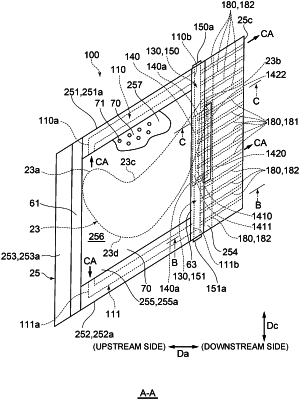| CPC F01D 5/187 (2013.01) [F01D 9/023 (2013.01); F01D 9/041 (2013.01); F02C 7/18 (2013.01); F05D 2220/32 (2013.01); F05D 2240/81 (2013.01); F05D 2260/201 (2013.01); F05D 2260/202 (2013.01)] | 19 Claims |

|
1. A turbine stator vane, comprising:
an airfoil portion;
a shroud disposed on at least one of the side of a tip end portion or the side of a root end portion of the airfoil portion; and
a protruding portion protruding toward the opposite side to the airfoil portion across a gas path surface in a radial direction,
wherein the shroud includes:
a circumferential-direction passage disposed at the side of a trailing edge and extending in a circumferential direction; and
a plurality of trailing edge end portion passages arranged in the circumferential direction at the side of the trailing edge, each trailing edge end portion passage having a first end portion connected to the circumferential-direction passage and a second end portion having an opening on a trailing edge end surface of the shroud,
wherein the circumferential-direction passage includes, in a cross-sectional view as seen in the circumferential direction, an oblique passage having a third end portion to protrude closer to the gas path surface toward the side of a leading edge, and a fourth end portion formed at the side of the trailing edge with respect to the third end portion, the oblique passage having an opening portion disposed on a trailing-edge side end surface of the protruding portion and closed by a lid portion, and
wherein a position, in an axial direction, of the first end portion where each trailing edge end portion passage connects to the circumferential-direction passage is positioned at the side of the leading edge with respect to a position of the trailing-edge side end surface of the protruding portion at a position where the protruding portion connects to the shroud.
|